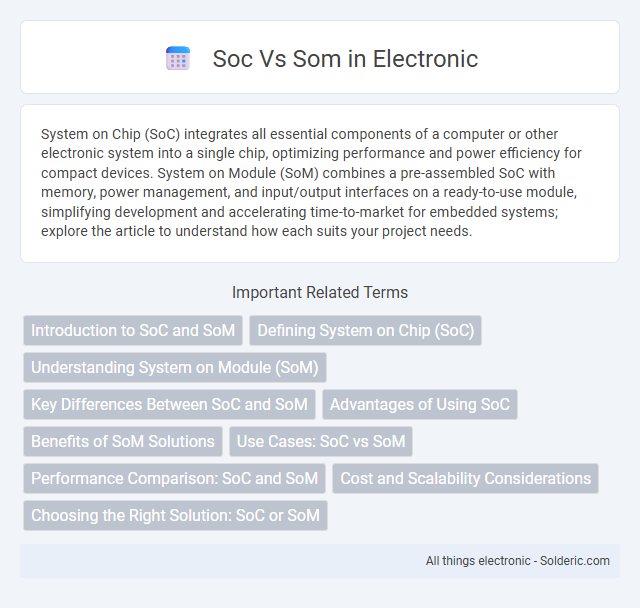System on Chip (SoC) integrates all essential components of a computer or other electronic system into a single chip, optimizing performance and power efficiency for compact devices. System on Module (SoM) combines a pre-assembled SoC with memory, power management, and input/output interfaces on a ready-to-use module, simplifying development and accelerating time-to-market for embedded systems; explore the article to understand how each suits your project needs.
Comparison Table
| Aspect | System on Chip (SoC) | System on Module (SoM) |
|---|---|---|
| Definition | Integrated circuit that combines CPU, GPU, memory, and peripherals on a single chip. | Compact board containing a SoC plus additional components like memory and power management. |
| Integration Level | Highly integrated single chip solution. | Module combining SoC and essential components for easy integration into custom designs. |
| Flexibility | Limited customization; fixed hardware design. | Flexible integration with carrier boards for tailored applications. |
| Development Time | Longer due to designing around the SoC. | Reduced, plug-and-play module accelerates time-to-market. |
| Cost | Lower per unit for mass production. | Higher initial cost; saves on development expenses. |
| Use Cases | Mobile devices, embedded systems, consumer electronics. | Prototyping, complex system integration, industrial automation. |
Introduction to SoC and SoM
System on Chip (SoC) integrates multiple components like CPU, GPU, memory, and peripherals onto a single silicon chip, optimizing performance and power efficiency for compact electronic devices. System on Module (SoM) builds upon SoC by incorporating the chip alongside memory, power management, and connectivity elements on a small board, simplifying development and accelerating time-to-market for embedded applications. Your choice between SoC and SoM depends on whether you prioritize custom hardware design flexibility or rapid product deployment.
Defining System on Chip (SoC)
A System on Chip (SoC) integrates all essential electronic components of a computer or other electronic system into a single chip, including the processor, memory, input/output ports, and secondary storage interfaces. SoCs are designed for compactness, power efficiency, and high performance, making them ideal for smartphones, tablets, and embedded systems. Understanding your device's SoC helps optimize performance and energy consumption tailored to its specifications.
Understanding System on Module (SoM)
System on Module (SoM) integrates a complete system, including processor, memory, and I/O interfaces, into a compact module designed for seamless embedding in various applications. Unlike standalone System on Chip (SoC), SoM offers enhanced modularity and faster time-to-market by simplifying hardware design and enabling easy upgrades or customization. This modular approach supports diverse industries such as industrial automation, medical devices, and IoT solutions, optimizing performance and reducing development costs.
Key Differences Between SoC and SoM
System on Chip (SoC) integrates all core components like CPU, GPU, memory, and I/O interfaces onto a single silicon chip, optimizing performance and power efficiency for compact devices. System on Module (SoM) combines an SoC with additional components such as memory, power management, and connectivity options on a small module, simplifying development and accelerating time-to-market. Your choice between SoC and SoM depends on whether you prioritize highly customized integration (SoC) or faster, flexible design implementation (SoM).
Advantages of Using SoC
System on Chip (SoC) offers significant advantages including reduced power consumption and increased performance by integrating multiple components such as CPU, GPU, and memory on a single chip. SoCs enable compact device design and lower manufacturing costs compared to System on Module (SoM), which typically relies on separate modules. Enhanced scalability and faster data transfer rates in SoCs improve efficiency for mobile devices, IoT applications, and embedded systems.
Benefits of SoM Solutions
System on Module (SoM) solutions offer significant benefits including accelerated development time, reduced design complexity, and enhanced scalability for your embedded projects. By integrating essential components like processors, memory, and interfaces into a compact module, SoMs simplify hardware design and facilitate faster product iterations. These advantages enable efficient resource management and quicker time-to-market compared to traditional System on Chip (SoC) customization.
Use Cases: SoC vs SoM
SoC (System on Chip) integrates multiple components like CPU, GPU, and memory on a single chip, making it ideal for smartphones, wearables, and compact IoT devices requiring high performance and low power consumption. SoM (System on Module) includes a SoC along with memory, storage, and input/output interfaces, simplifying development and accelerating time-to-market for customized embedded systems, industrial automation, and robotics. Your choice depends on whether you need a fully integrated solution with minimal design effort (SoM) or a more customizable, chip-level design for mass production (SoC).
Performance Comparison: SoC and SoM
System on Chip (SoC) generally offers higher performance efficiency by integrating multiple components on a single silicon chip, resulting in faster processing speeds and lower latency. System on Module (SoM) provides flexibility and easier scalability but may exhibit slightly lower performance due to modular interfaces and additional communication overhead. Your choice should balance raw performance needs with the benefits of modular design and upgradeability.
Cost and Scalability Considerations
System on Chip (SoC) offers cost efficiency by integrating multiple components into a single chip, reducing manufacturing and assembly expenses. System on Module (SoM) provides scalable benefits by enabling easy upgrades and customization through modular design, which can lower development costs over time. SoCs are ideal for high-volume production with fixed specifications, while SoMs better support diverse applications requiring flexibility and incremental scalability.
Choosing the Right Solution: SoC or SoM
Choosing between a System on Chip (SoC) and a System on Module (SoM) depends on your project's complexity and customization needs. SoC integrates all components on a single chip, offering high performance and low power for compact designs, while SoM provides a pre-designed module with essential functions for faster development and easier integration. Your decision should align with scalability, time-to-market requirements, and the desired level of design flexibility.
soc vs som Infographic

 solderic.com
solderic.com